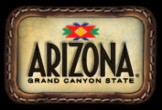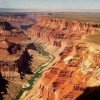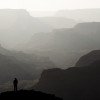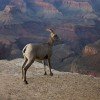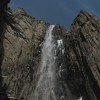Contents
Route description
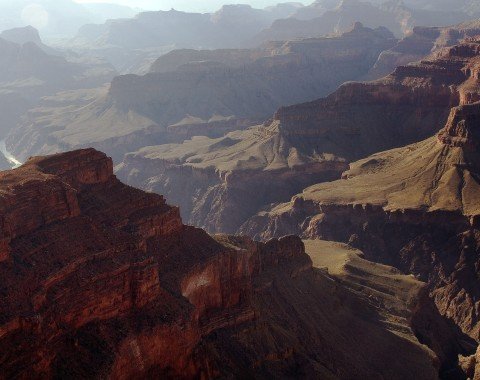
It is very popular to do this impressive hike in the months of October to April/ May. Therefore, if you want to be alone with the greatness of nature, chose to go between March and November. Advisable is also to do the tour in four days, in order to not strain yourself too much and to be able to capture as much as possible from the Grand Canyon, even though it might be possible to do the hike in a day's time.
It is also of high importance to start the daily stage of the hike while the sun has not risen yet. It is the only way to avoid hiking at midday during very high temperatures. Infact, some parts of the route might be closed at noon because of the heat.
Day 1: North Rim to Cottonwood Camp
The tour starts at the Roaring Springs Canyon, which continues to impress with its evergreen woods. You will reach the Supai Tunnel after about two miles from where the landscape changes drastically. Now you will find an imposing desert area.
From there you will walk downhill most of the time. Prepare yourself to hike an inclination of 1.3 miles per five miles (2 for 8 km). Roaring Springs will be reached less than two miles further. Here the Roaring Canyon actually combines with the much bigger Bright Angel Canyon. Whilst keep walking through the Bright Angel Canyon, you will eventually get to a hut that provides the entire area with water using a special pump. Make sure to take a rest here and refill your water supplies. It will be another 1.3 miles to the camp.
The Cottenwood campground will then be an ideal place for your first overnight stay. You will find a cabin, a water tank and a rarely busy ranger station right next to the campsite here. There are many neat areas where you can rest and the cool Angel Creek to wash yourself, since there are no showers or such.
Day 2: From Cottonwood Camp to the Bright Angel campground
Even though the route on the next day is fairly even, it sets challenges yet again. One of the challenges is a canyon with the intriging name “The Box”. It got that name for a reason: Especially during the high temperatures at noon you will get the feeling of walking through hell, but as Winston Churchill once said: “If you're going through hell, keep going.” And keep on going you will to reach the Phantom Ranch. Obviously it is nevertheless of great advantage to get through “The Box” Canyon before noon; there is no need to experience hell on earth. The place for your second overnight stay will then be less then a mile away from the Ranch.
“Bright Angel” is the name of the campground you will stay at for the night and its greatest attraction is the underneath lying beach right by the Colorado River. The campground itself provides tap water and washbasins.
Day 3: From Bright Angel to Indian Garden campground
First things first, you should really get up early on Day 3. The hike starts with the crossing of the Colorado River on the Silver Bridge, before the trail continues to amaze with the beauty of its landscape, always being beside the river. In spite of it being a trail with quite a hilly profile, there are nonetheless no significant obstacles on this part of the way.
The trail turns to the Pipe Canyon on the equally named creek, which is situated in the interior territory. You will reach the so called “The Devil's Corkscrew” a couple miles later. Hereby the name is very fitting as well: The path winds is way upwards on one side of the canyon, which can be a sheer deadly trap in the hot midday sun. Therefore it is again beneficiary to leave the campground in the morning. Approximately 9:30 am would be an ideal time to get “The Devil's Corkscrew” over with.
At the top the trail continues further towards another canyon within the plateau that leads your way to Indian Garden and the equally named campground.
In comparison with the former campgrounds, the Indian Garden will feel like pure luxury. You will find more than enough areas with a cooling shadow and you can rest beside the river that goes through the area on one end. At the same time the river offers you the possibility to wash, whereas there are no facilities of such kind directly in the campsite.
Day 4: From Indian Garden campground to the Bright Angel Trailhead
The last stage of the Grand Canyon hike is often to be considered as “intimidating”. Would you agree? Go ahead and gain your own perspective of the hike!
As usual you should get up early to avoid the hot midday sun. Then the hike starts of exciting, as a climbing tour awaits you. It is of high importance to make sure not to exhaust oneself somewhere during the trip. Every one to two miles the trail offers great resting spots, where it is advised to take a break, at least to get fresh water. This stage of the hike will take you about six hours entirely, including breaks of a half an hour each.
Last but not least you will reach the Bright Angel Lodge, the final destination of your trip. Don't forget to get a “Rim to Rim” t-shirt here, a great reminder of this fascinating hike.
The Bright Angel Lodge offers numerous options for an overnight stay. All of them are placed in different locations, with a unique view of the South Rim. The rooms are provided with their own shower as well.
You can easily return from the neighbored Grand Canyon Village to the starting point of your journey.
Where to eat
Above all the Grand Canyon is a desert landscape. Thus it is at your own responsibility to bring enough to eat and drink for each day.
However, you do pass the so called “Phantom Ranch” on the second day of the trip where you can purchase beer in the air conditioned room. Simply an ideal place for a break.
You can also get something to eat right at the end of your hike at the Bright Angel Lodge. Here you will find numerous places to eat in the neighbored Grand Canyon Village as well.
Interesting facts
- With an overall length of 85 km the hike is currently the longest hike in the USA available on TouriSpo.
- Grand Canyon – Rim to rim is among the 3 best rated Hikes in the USA.
- Elevated between 1,155 m and 2,088 m, the hike is among the 3 highest elevated hikes in the USA. You're facing an uphill climb of 133 vertical meters on this hike. The track is therefore relatively flat.
- Sturdy hiking boots are recommended on this track. There are places to buy beverages and food along the track. However it’s always recommended to bring enough water and food along with you.
Video
Highlights of the tour
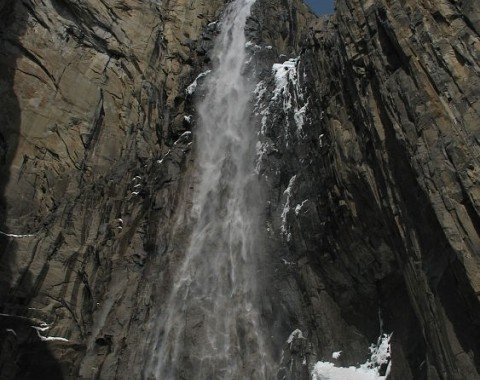
If you're not too exhausted after your trip on Day 1, make sure to plan in a short extra trip to the Ribbon Watterfalls, which are less than 1.5 miles away from the campground. The coolness of the water will be just the refreshment you need after a long day of hiking.
Another great highlight is the viewing platform about 1.5 miles away from the Indian Garden campground you will reach on the third day. There is nothing like experiencing the sun set on this special spot. It is not only the sun that amazes to fascinate every day, but the spectacular light play on the rocks of the Grand Canyon.
If that is not enough, it is worth taking this hike simply because of the very unique landscape. While you start your hike in the woods, you will be astonished by the colorful play of light and shadow within the Grand Canyon rocks.
Variations
Of course you can hike the tour the other way around, from the South Rim to the North Rim. Beware however that this way is a lot more challenging.
Equipment
While hiking the Grand Canyon, make sure to bring:
- Enough water! It is of high importance to stay hydrated at all times
- Enough to eat: Especially salty food can be essential. You should be eating twice as much as usually
- A first aid kit
- A map for orientation even though the trails are signposted
- A back pack for transportation purposes
- A flashlight with fresh batteries, since you will be starting to hike with not much light in the early morning
- A spray bottle with water to refresh
- A hat and lots of sunblock with a high sun protection factor
- A whistle or something close to that to make yourself noticed in case of emergency
- Waterproof clothes, especially during the time between mid July and the beginning of September
It is also important that you always make yourself aware of what you can and what you can't do. There is a possibility that there will be no help right away, especially during the summer months; Be it because of the heat, too many emergency calls or missing personal.
Getting here
The entrance to the Grand Canyon National Park in Arizona is located 30 miles (48km) away from the Jacob Lake on the Highway 67. The very northern edge is situated about 9 miles (14km) further down south.
With the air plane:
There are numerous airlines operating to the airports of Phoenix, Salt Lake City and/ or Las Vegas. Moreover, there are flights to the St. George airport from Salt Lake City and Los Angeles. St. George is about 156 miles (251 km) away form the North Rim of the Grand Canyon.
By car:
On request there are shuttle-services between Flagstaff, Sedona or Williams and the Grand Canyon Nationalpark and the North and South Rim.
Furthermore, you can make use of the Trans Canyon Shuttle that takes you from the North to the South Rim, or the other way around. However, this shuttle just operates back and forth once a day and from 15 May to 15 October only. There is a restricted time table until 31 October. You should plan with about 4.5 hours of time for the trip with the shuttle.





